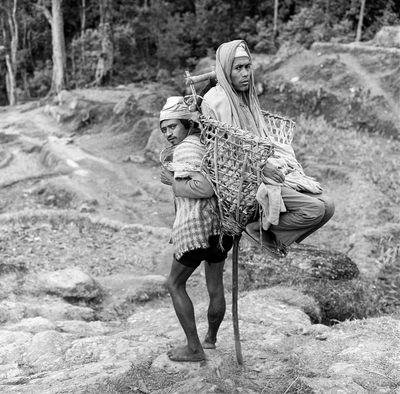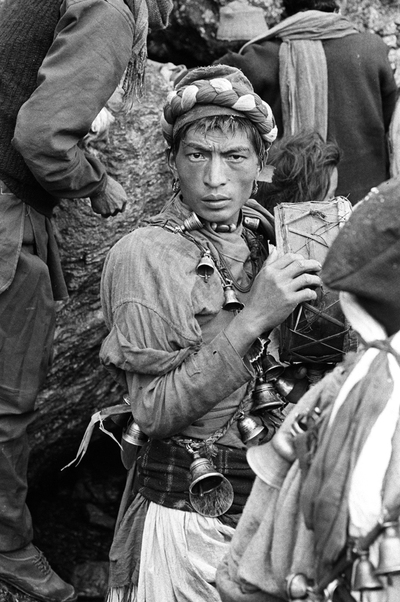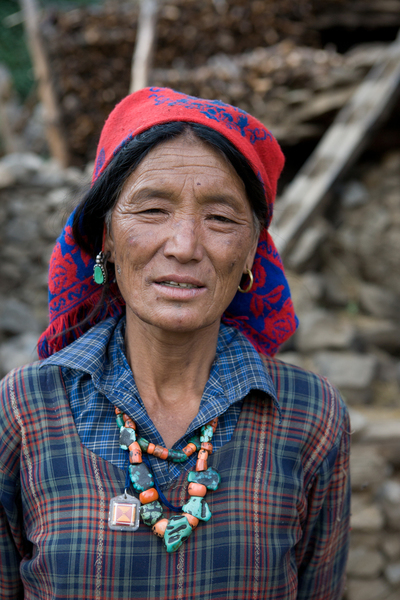Nepal 1975-2011: Kevin Bubriski Photographs
by Bret Chenkin
One could argue that the age of ethnographic photography is over. That putative golden age when European explorers and adventurers went forth to unknown regions—risking life and limb in deserts, ice fields or jungles—seeking the strange and undiscovered peoples of these lands, and collecting their artifacts and images for both research and to share with a curious public back home. That is not to say that such adventurers do not still forge on into remote sectors of our ever shrinking planet and photograph elusive native groups, but this is a trickle compared to what happened a century or more ago. The death knell was not only political sensitivity, but the fact that many folk are now aware of and empowered with technology. Often, when they are snapped at, they snap back. However, as long as there are skilled photographers such as Kevin Bubriski, the genre of ethnographic or documentary photography will never become obsolete or be eclipsed by a decentralized or informal gaze. As evidenced by his recent publication by Peabody Books, Nepal 1975-2011, an adept and insightful eye will always reveal thought-provoking ways to engage another world.
Nepal is one of those mysterious places to Western ears. The name conjures visions of bleak, brazen snow peaks and industrious Sherpas shouldering multicolored bags for privileged mountaineers; one sees the elusive snow leopard or isolated stupas festooned by prayer flags. It is land steeped in antiquity. It is this world which Bubriski stumbled into as a young Peace Corps worker—helping a remote village construct wells in 1975. Assigned to the mountains, he took to his job with relish, and as he traveled, he carried with him a small 35 mm Leica, and unabashedly documented the sublime views about him. The love affair began, and he returned numerous times over the course of 40 years—changing the types of camera he used from handheld to large format. He as constantly documenting, capturing the peoples and landscape—intermixed mostly—the proud tribes and workers, city vendors and religious devotees, parents and children, all engaged in their daily tasks and framed by a lovely terrain.
The book features the work from these travels and is moving on many levels. For one thing, one gets to see through these images the transition of a nation as it goes from near-primitive status through a period of war and instability to a globalized space now developing at a rapid pace and stressed between Indian and Chinese cultural forces. But on a more humane level, the pictures selected for this book speak of people; Bubriski is a photographer who follows the path laid down by Edward Curtis, Henri Cartier-Bresson and Milton Rogovin. These are ethnographic portraits in which the subject, though often quite consciously posed, exchanges a glance with us so that we may share in their world. Despite the absolute difference in culture and in time, these people still engage the world as we do—through love, determination, struggle and survival.
The book is divided into six sections, not including the preface and prologue and each of these sections features a visit to Nepal. The photographs are accompanied by Burbriski’s comments, which offer some contextual information, without ever taking from the image itself. His work is a great survey from lamas to bricklayers to soldiers to Gurung girls in traditional garb to Hindu devotees in misty woods to young mothers and fathers in remote mountain villages lovingly nurturing their children. All these walks of life are captured in glorious silvers, and all of these Nepalese, no matter how abject their poverty, evoke deep pride and a strong will. In my opinion the earliest works appear stronger—have more visual dynamism and authenticity—but it could be that the last trips, in the 2000, are printed in color and seem less mysterious. What is effective in the color prints is how much more accessible this world is, they bring a viewer sitting half the world away that much closer. Anyone who reads Bubriski’s photographic journal will be satiated visually, artistically and culturally.
________________________________________________________________________________________________
Image Credit: Images courtesy of Kevin Bubriski.
________________________________________________________________________________________________
Bret Chenkin is a freelance writer living in Bennington, Vermont. He has been writing reviews for Art New England for over ten years.




